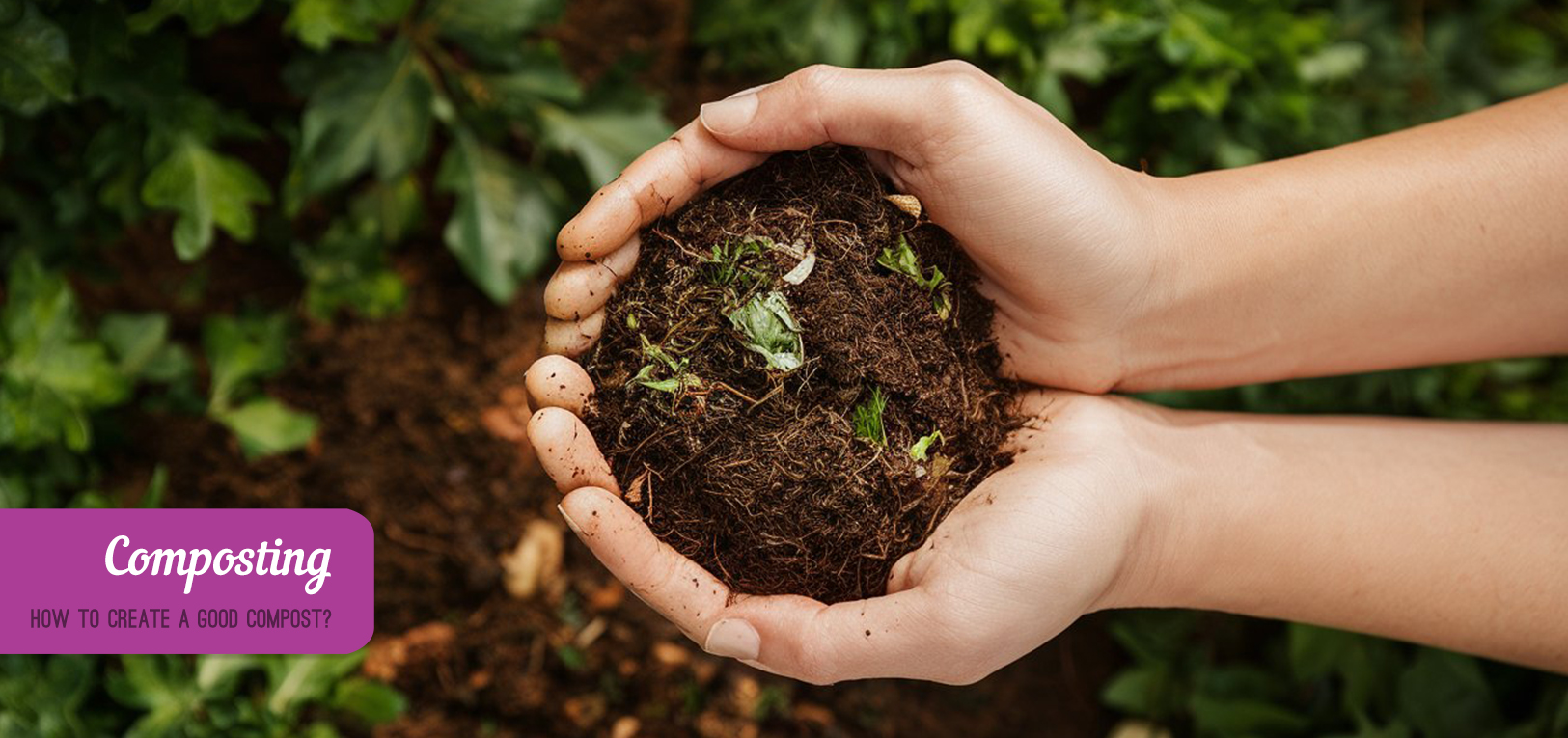Your cart is currently empty!

What Is Composting?
Composting is a simple and eco-friendly way to turn food scraps and yard waste into a nutrient-rich soil amendment. A natural process where microorganisms like bacteria and fungi break down organic materials like food scraps, leaves, and grass clippings into a dark, crumbly soil called compost. This compost can then be used to enrich your garden soil, improve drainage, and support healthy plant growth.
Composting offers several benefits:
1. Reduces Waste: Composting helps divert organic waste from landfills, reducing greenhouse gas emissions and supporting a more sustainable environment.
2. Improves Soil: Compost enriches soil with essential nutrients, improving its structure and fertility.
3. Supports Healthy Plants: Compost helps plants grow strong and healthy by providing the necessary nutrients.
What are Types of Composting?
There are several types of composting methods, each with its own unique characteristics and requirements. Here are some common methods and their examples, along with the approximate time needed for each to be completed:
1. Aerobic Composting
- This method involves the decomposition of organic matter by microorganisms in the presence of oxygen.
- Examples: Berkley rapid composting, North Dakota State University hot composting, and IBS rapid composting.
- Time Needed: 2 weeks to 6 weeks, depending on the method and frequency of turning.
2. Vermicomposting
- This method uses worms to break down organic waste into a nutrient-rich compost.
- Examples: Vermicomposting with worms.
- Time Needed: 4-5 weeks, depending on the size of the worm bin and the amount of organic matter.
3. Anaerobic Composting
- Description: This method involves the decomposition of organic matter without oxygen.
- Examples: Anaerobic composting, Bokashi composting.
- Time Needed: 3-6 months, depending on the method and the amount of organic matter.
4. Windrow Composting
- This method involves creating long, narrow piles of organic waste and periodically turning them to promote decomposition.
- Time Needed: 2-3 months, depending on the size of the windrows and the frequency of turning.
5. In-Vessel Composting
- This method involves composting organic matter within a controlled environment, such as a compost tumbler or a silo.
- Time Needed: 2-6 weeks, depending on the size of the vessel and the amount of organic matter.
6. Static Pile/Bin with Passive Aeration
- This method involves creating a compost pile or bin with passive aeration, allowing for decomposition to occur without frequent turning.
- Time Needed: 3-6 months, depending on the size of the pile and the amount of organic matter.
7. EM-Based Quick Composting
- This method involves using effective microorganisms (EMs) to accelerate the composting process.
- Time Needed: 4-5 weeks, depending on the method and the amount of organic matter.
8. Composting with Black Soldier Fly (BSF)
- This method is popular among farmers and gardeners lately due to the capabilities of producing an extra protein source feed for the stock. The other featured capabilities are, just like worms, BSF maggots are able to quickly compost meat based waste as well as help bone degradation. BSF, unlike the other fly species, does not host harmful microbes, instead adding or attracting the beneficial ones.
- Time Needed: 1-2 days, depending on the size of the pile and the amount of organic matter.
9. Other Composting method: Ecuador On-Farm Composting: There are many more various methods of composting adjusted to the features available in their environment and the need of the composter, such as Chinese High-Temperature Composting, Ecuador On-Farm Composting, Indore Pit Composting, and many others.
These methods vary in terms of labour, energy, land use, time, and volume of materials. Choosing the right method is crucial for a composting program’s success. Each method has its own benefits and drawbacks, and the choice of method depends on the specific needs and resources of the composting site.
How to Make a Simple Compost?
To start composting, you’ll need a few basic things:
- Compost Bin: You can use a dedicated compost bin or even a pile in your yard. The bin should have a lid to keep pests out and retain heat.
- Materials: Add a mix of green materials (like food scraps, grass clippings, and fresh leaves) and brown materials (like dried leaves, twigs, and shredded newspaper). The usual good composition of materials for composting is a 50:50 balance between “green” and “brown” materials. “Greens” are quick to rot and provide nitrogen and moisture, while “browns” are slower to rot and provide carbon and fiber, helping to create air pockets. Examples of “greens” include fruit and vegetable peelings, grass clippings, and tea bags. Examples of “browns” include autumn leaves, egg shells, and cardboard. This balance helps to create a stable and nutrient-rich compost
- Water: Keep the pile moist, like a damp sponge.
- Turn the Pile: Every few weeks, turn the compost pile to aerate it and speed up the decomposition process.
Tips and Tricks:
- Avoid Contaminants: Don’t add meat, dairy, or oily foods to your compost, as they can attract pests and create unpleasant odours.
- Monitor Temperature: Compost piles can get hot, so check the temperature regularly to ensure it’s within a safe range (50°F to 150°F).
- Be Patient: Composting takes time, so be prepared to wait several months for your compost to mature.
Can Manure Be Included in Composting? Yes, Here’s How!
Composting is a fantastic way to turn food scraps and yard waste into nutrient-rich soil. But did you know you can also include animal manure in the process? It’s a great way to manage waste, reduce odours, and create a valuable soil amendment.
Herbivores like cows, goats, and sheep produce manure that is relatively low in nitrogen and high in carbon. This makes it easier to compost and creates a stable, odorless final product. Omnivores like pigs, chickens, and ducks produce manure that is higher in nitrogen and lower in carbon, thus naturally having a stronger odour than the herbivores, a bit more challenging to compost.
Here’s a step-by-step basic guide on how to compost manure from both herbivores and omnivores:
- Collect and Store Manure: Collect the manure and store it in a dry, covered area until you have enough to start a compost pile. If the manure is wet, add dry materials like straw or sawdust to balance the moisture content.
- Build the Compost Pile: Choose a well-draining location with good air circulation. The pile should be at least 3 feet high and 3 feet wide to generate enough heat for effective composting. Layer the manure with dry materials like straw or leaves, and add water to moisten the pile.
- Monitor Temperature: Use a compost thermometer to monitor the temperature of the pile regularly. The ideal temperature range is between 131°F to 150°F (55°C to 65°C). If the temperature drops below this range, turn the pile to aerate it and add more dry materials to balance the moisture content.
- Turn the Pile: Aerate the compost pile by turning it with a pitchfork or a compost turner. Turning the pile helps distribute oxygen and heat throughout the pile, ensuring all organic matter is composted evenly. Turn the pile every few days for the first week, then every week or two thereafter.
- Harvest the Compost: The compost is ready when it is dark brown, crumbly, and has no odour. This process can take anywhere from 1 to 6 months, depending on the composting conditions. Use the finished compost to amend garden soil, top dress plants, or as a potting mix.
TIPS & TRICKS:
I use lidded plastic bins that are relatively big in size (since we need to pile them for 3 to 6 months until they mature). I put enough holes surrounding the plastic container for the worms to enter. I dig the ground deep enough to immerse the container inside the ground (this is to ensure it keeps warm and available for the worms workers). Put some big stones on the bottoms of the container to avoid the composted manure and carbon materials blocking the access of the worms. Spray EM (Effective Microorganisms) solution on every layer of compost you add to make the process quicker. You still need to stir the upper layer every now and then, but worms will do the most job. In my case (however I live in a warm weather country), it would probably take about 3 months for an omnivore manure and 1-2 months for herbivore manure to be completed (depending on the weather and environment).
Likewise, I do some experiments with BSF maggots for composting the manure. We mix the carbon materials, organic waste, manure, and EM as their daily feeding. And Whallah! It took them only a day or two to make all the feed disappear and odourless. However, you need to consider how much BSF maggots army you have and how much feeding will not choke them up.
Can we mix worms and BSF?
Technically you can. BSF is degrading the organic waste for the worms. However, if BSF maggots feel they don’t get enough feeding, in some cases they think worms are their extra feedings. You need a big container and free access for worms to run away from them.
Special Notes about the Bokashi Composting Method
Bokashi composting is a type of anaerobic composting method that uses microorganisms to break down organic waste. It is a fermentation-based process that involves adding microorganisms to the waste, which then breaks down the organic matter into a nutrient-rich compost.
Key Features of Bokashi Composting are:
- Anaerobic Environment: Bokashi composting occurs in the absence of oxygen, which allows microorganisms to thrive in the absence of oxygen.
- Microorganisms: Bokashi composting uses a specific type of microorganism called Effective Microorganisms (EM) to break down organic waste.
- Fermentation Process: The microorganisms in the bokashi composting process break down the organic waste through a fermentation process, which involves the conversion of organic matter into simpler compounds.
- No Heat Required: Unlike aerobic composting methods, bokashi composting does not require heat to break down the organic waste.
- Fast Composting: Bokashi composting can produce compost in as little as 1-2 weeks, depending on the amount of waste and the microorganisms used.
- No Odors: Bokashi composting is known for producing minimal odours, as the microorganisms break down the organic waste in a controlled environment.
- No Turning Required: Unlike aerobic composting methods, bokashi composting does not require turning the compost pile to ensure adequate oxygen levels.
Benefits of Bokashi Composting:
- Fast Composting: Bokashi composting can produce compost in a short period, making it ideal for small-scale composting operations.
- Minimal Odors: Bokashi composting produces minimal odours, making it a more discreet and convenient composting method.
- No Turning Required: Bokashi composting does not require turning the compost pile, making it easier to manage and maintain.
- High-Quality Compost: Bokashi composting produces a high-quality compost that is rich in nutrients and beneficial microorganisms.
Challenges of Bokashi Composting:
- Limited Capacity: Bokashi composting is typically used for small-scale composting operations, as it can only handle a limited amount of waste.
- Specialized Microorganisms: Bokashi composting requires specialized microorganisms, which can be difficult to obtain and maintain.
- Monitoring pH Levels: Bokashi composting requires monitoring pH levels to ensure that the microorganisms are thriving and breaking down the organic waste effectively.
Tips for Successful Bokashi Composting:
- Use the Right Microorganisms: Use the right type of microorganisms specifically designed for bokashi composting.
- Monitor pH Levels: Monitor pH levels to ensure that the microorganisms are thriving and breaking down the organic waste effectively.
- Add the Right Amount of Water: Add the right amount of water to the compost pile to ensure that the microorganisms are thriving.
- Maintain a Consistent Temperature: Maintain a consistent temperature between 50°F to 150°F (10°C to 65°C) to ensure that the microorganisms are thriving.
- Add Bulking Agents: Add bulking agents such as sawdust or coconut coir to the compost pile to help absorb excess moisture and improve aeration.
Bokashi composting is a unique and effective method for breaking down organic waste. It is ideal for small-scale composting operations and produces a high-quality compost that is rich in nutrients and beneficial microorganisms. However, it requires specialized microorganisms and monitoring pH levels to ensure successful composting.
Conclusion, Tips Tricks, & Notes of Composting from Me
In my case, after researching various kinds of composting methods and ideas for both small farming and household, I find Black Soldier Fly (BSF) and Bokashi are the most suitable to use interchanging or combined (depending on what you are composting). BSF has the most range of organic material composting capabilities and the most quick. We don’t have enough time or hands to turn or mix our compost bin every day, so the Bokashi method is best used for manure composting. For Aerobic composting: I mix organic waste with carbon materials and a bit of manure sometimes to add decomposter microbes into the compost. I spray EM solutions to make the process quicker. The mixing process is done by my little minions, either BSF maggots or Worms.
So there you go… A brief note and basic explanation about composting. I hope by following these simple steps and tips, you can start composting and contribute to a more sustainable future. Don’t hesitate to experiment with your composting method until it is suitable. However, start the experiment on a small scale before applying it to a larger scope.
Happy composting and greens growing!
Here are my other green farming articles that might be useful if you interested to have your own small green farming and planting inside your home:


Leave a Reply